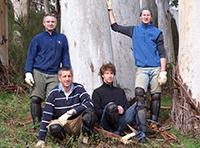News stories
- NGER reporting – it’s here to stay
- Update on carbon policies
- Focus Press & NCOS
- We offer NABERS – National Australian Built Environment Rating System
- Rise of the Eco-Warriors (Project Borneo)
- Hands on action!
Miss our last newsletter?
NGER reporting
It’s here to stay. Are you prepared?
 Whichever course the Federal Government does take on carbon pricing, the National Greenhouse and Energy Reporting Act (NGER) and associated legislation such as Energy Efficiencies Opportunites (EEO) are here to stay.
Whichever course the Federal Government does take on carbon pricing, the National Greenhouse and Energy Reporting Act (NGER) and associated legislation such as Energy Efficiencies Opportunites (EEO) are here to stay.
Organisations reaching 25kt CO2e or 100TJ thresholds at a facility level, or double that at a corporate level, are still liable for mandatory reporting and rigorous methodologies. As reporting for FY12/13 has just come to a close, right now is the best time to review your systems and consider improvements.
Be confidently positioned to demonstrate NGER compliance
To fulfill the legislative requirements of the NGER Measurement Determination, each data source must be documented to describe in detail: ownership, data format, and data quality. Three essentials:
- A clear and auditable record of data sources,
- Allocated staff resources responsible for collecting and processing the data,
- Applied calculations and methodologies enabling you to present this information for reporting purposes.
If you haven’t reviewed your NGERs reporting methodology for the last four years, now is the time. You will have the opportunity to implement changes or improvements before next July.
Make your reporting task easier
We have a wide range of experience under the NGER and EEO Acts. With over 1,000 carbon and energy audits completed, we are well placed to make recommendations.
We can also provide a carbon management software solution, CarbonView, to streamline NGER and EEO reporting processes.
Other ways we help with NGER reporting
NGER reporting overview assessment:
Particularly for first-time reporters and for those who want a detailed process review, we assess your NGER reporting process against our NGER Audit Trail Framework. We provide better-practice recommendations to assist you in achieving an effective, efficient and repeatable process.
NGER report verification and assurance:
Our auditing team can help with technical verification and assurance over your NGER report. This is in accordance with the NGER (Audit) Determination 2009. We also work with our accounting partners to provide a level that can be tailored to either ‘reasonable assurance’ or ‘limited assurance’ to meet your needs.
NGER reporting process assistance:
We can help your organisation prepare your NGER report or design, and implement a robust NGER internal control and reporting process. This will support efficient and accurate reporting under the NGER Act.
- Read more on our NGER services and EEO services
- See an NGER case study: WestSide Corporation
- Back to top
Update on carbon policies
Guest writer: Peter Hawkes, formerly Partner at law firm Herbert Geer
 In this article we provide a summary update on important potential developments within the realm of Clean Energy and Carbon Law. This includes:
In this article we provide a summary update on important potential developments within the realm of Clean Energy and Carbon Law. This includes:
- the proposed repeal of the Carbon Pricing Mechanism;
- design issues for the proposed Emissions Reduction Fund; and
- the Draft Report on Australia’s National Emissions Targets and Pollution Caps for the Carbon Pricing Mechanism.
Some aspects of these developments are quite detailed and technical and we encourage you to assess the potential risks and opportunities to your current and planned activities.
Carbon Pricing Mechanism update
Consultation on proposed repeal
The Federal Government has released for consultation draft legislation to dismantle the Carbon Pricing Mechanism (and equivalent carbon pricing measures).
View copies of the draft Bills.
Key purpose
The key purpose of the consultation is to identify and manage transitional issues for liable businesses and other entities.
This is important because the Carbon Pricing Mechanism will still continue to operate for the “fixed charge years” of FY13 and FY14.
Whether the Carbon Pricing Mechanism will continue to operate for FY15 and future years depends on the outcome of the parliamentary process. The first Senate vote on the “repeal bills” (to be passed by the House of Representatives in mid-November 2013) could result in a range of outcomes including:
- accepting the Bills without amendment;
- amending one or more of the Bills without division;
- amending one or more Bills by division – the Main Repeal Bill could be divided into 2 Bills to separate the “FY15 issue” (e.g. reducing the “fixed charge” for FY15 to $0 or converting the “fixed charge year” to a “flexible charge year”) from the continued operation (or replacement) of the Carbon Pricing Mechanism for FY16 and/or future years; or
- rejecting the Bills.
The above list is not exhaustive however it indicates a broad range of potential changes in law.
Here are two things you can do:
- check your relevant contracts to ensure that they adequately deal with each potential change-in-law scenario; and
- consider making a last minute submission on the draft legislation – the deadline for submissions is this Monday 4 November 2013.
Emissions Reduction Fund
Consultation on proposed design
The Federal Government has released for consultation the terms of reference for the design of the Emissions Reduction Fund.
The fund is proposed to commence operations on 1 July 2014. It is a key component of the Direct Action Plan.
Key objective
The key objective of the Emissions Reduction Fund is to efficiently and effectively source low cost emissions reductions that will contribute towards achieving Australia’s National Emissions Target for 2020: 5% below 2000 levels.
Issues to consider
- a design that can be established quickly to facilitate commencement of operations on 1 July 2014;
- an umbrella framework to guide the development of additional design issues after 1 July 2014 and through to 2020;
- what qualifies as “low cost emissions reductions” (e.g. Australian Carbon Credit Units);
- which “qualifying emissions reductions” can actually be delivered by 2020;
- who will be tasked with acquiring the “qualifying emissions reductions”;
- how the acquisition of “qualifying emissions reductions” will be funded;
- how the “qualifying emissions reductions” will be acquired (e.g. auction for immediate delivery);
- how the “qualifying emissions reductions” will be delivered (e.g. link auction mechanism with the Australian National Registry of Emissions Units);
- the risks of delivery failure if acquisition rules allow for investment in projects to generate “qualifying emissions reductions” for delivery by a specified Date for Delivery;
- how issues associated with the acquisition of “qualifying emissions reductions” will be separated from issues associated with the generation of “qualifying emissions reductions”;
- how the efficiency of developing and approving methodologies for generating “qualifying emissions reductions” under the Carbon Farming Initiative can be improved;
- the purpose of establishing industry / entity / facility specific emissions baselines (e.g. generate “qualifying emissions reductions” if annual verified emissions are less than the baseline figure);
- the process for establishing these baselines (e.g. the use of data from the National Greenhouse and Energy Reporting (NGER) scheme and Energy Efficiency Opportunities (EEO) program); and
- the potential recognition of current emissions reduction activities in relation to emissions not covered by the operation of the Carbon Pricing Mechanism (or equivalent carbon pricing measures) to generate “qualifying emissions reductions” or to be factored into baseline calculations (e.g. “early start credits”).
The deadline for submissions on design issues for the Emissions Reduction Fund is Monday 18 November 2013.
Draft Report: Australia’s National Emissions Targets and Pollution Caps for the Carbon Pricing Mechanism
On 30 October 2013 the Climate Change Authority released for consultation its Draft Report on Australia’s National Emissions Targets and Pollution Caps for the Carbon Pricing Mechanism.
The Draft Report offers a range of options for National Emissions Targets and Pollution Caps that have been assessed for potential economic impacts and social impacts. This means that the draft report may be an important input to facilitate consideration of:
- the proposed repeal of the Carbon Pricing Mechanism;
- the design of the proposed Emissions Reduction Fund; and
- the review and improvement of existing (and development of new) additional complementary measures prior to 2020.
The deadline for submissions is Friday 29 November 2013.
About Peter Hawkes
At the time of writing Peter Hawkes was a Partner at Herbert Geer. He led the firm’s Clean Energy and Carbon Law Team and was a senior member of the Projects & Construction Group.
Focus Press & NCOS
Our newest case study
 Focus Press is an Australian-owned, award winning printing company. For 19 years Focus Press has been at the forefront of sustainability and innovation.
Focus Press is an Australian-owned, award winning printing company. For 19 years Focus Press has been at the forefront of sustainability and innovation.
Diligence and persistence has paid off. All offset and digital print products have received carbon neutral certification under the National Carbon Offset Standard (NCOS).
Pangolin verification services
 We provided third party verifications of Life Cycle Analysis (LCA) and Greenhouse Gas Inventory reports for the Focus Press NCOS application.
We provided third party verifications of Life Cycle Analysis (LCA) and Greenhouse Gas Inventory reports for the Focus Press NCOS application.
This is critical, final step in a rigorous application process. Our NGER registered auditors also acted as liaison. Pangolin was the key point of contact for the author of the NCOS Life Cycle Analysis and Greenhouse Gas Inventory reports, the Focus Press team, and the Federal Government’s Department of Environment.
Focus Press says…
We chose Pangolin Associates for our NCOS Verification due to their excellent reputation and professional approach. They had also completed our previous NCOS Verification and we had been very happy with their work. In particular, we valued their communication skills. Our Auditor took the time to explain in detail what the Verification entailed and, as the project progressed, they kept us informed and we always knew what was required of us.
We also like that the Pangolin staff are each leaders in their field. Working together with them we feel reassured of the depth of their knowledge and their ability to advise us of the most recent developments in the sustainabilty and carbon industries.
We would not hesitate to work with Pangolin Associates again if future opportunities arise.
Louise Pastro, Manager Sustainability and Stakeholder Engagement, Focus Press
September 2013
We offer NABERS
National Australian Built Environment Rating System

Did you know we offer NABERS?
As well as Energy Audits, our NABERS accredited assessor, Harald Grabner, can perform a rating of your building’s energy efficiency, water usage, waste management, and your office’s indoor environment.
Almost 70% of office space in Australia has a NABERS Energy rating. Building owners have used the system to their benefit to track and improve efficiencies and costs.
Whilst NABERS is largely a voluntary initiative, the rating is mandatory in some circumstances, such as leasing office space to the government.
Rise of the Eco-Warriors (Project Borneo)
A Virgo Productions documentary film
 It’s a story about 15 young people attempting to stop deforestation in Borneo. Rise of the Eco-Warriors is an Australian documentary film about taking action – DeforestACTION. Environmental responsibility is the message at every level of this project. Virgo Productions engaged us to measure and offset the documentary’s own carbon footprint.
It’s a story about 15 young people attempting to stop deforestation in Borneo. Rise of the Eco-Warriors is an Australian documentary film about taking action – DeforestACTION. Environmental responsibility is the message at every level of this project. Virgo Productions engaged us to measure and offset the documentary’s own carbon footprint.
Managing the documentary’s impact
We provided a Greenhouse Gas Assessment for the making of the documentary. We also purchased and retired carbon credits on behalf of Rise of the Eco-Warriors to fully offset its own emissions. Not surprisingly, the production team selected Forests Alive certified carbon credits. Forests Alive produce credits through Tasmanian forest conservation.
More about the film
 Rise of the Eco-Warriors follows a group of young, passionate people who spend 100 days in the jungles of Borneo. They are determined to save Borneo’s tropical rainforests from the devastation caused by the demand for commercial palm oil plantations. They fight for the rainforest and in particular for the endangered orangutan.
Rise of the Eco-Warriors follows a group of young, passionate people who spend 100 days in the jungles of Borneo. They are determined to save Borneo’s tropical rainforests from the devastation caused by the demand for commercial palm oil plantations. They fight for the rainforest and in particular for the endangered orangutan.
Promoted through social media and in schools, this film targets kids. The eco-warriors and DeforestACTION is now part of curriculum for over 60,000 students in Australia and beyond.
Rise of the Eco-Warriors is written and directed by award winning documentary maker Cathy Henkel. Henkel also created The Burning Season (2009).
- See more about Eco-Warriors
- Watch the trailer on YouTube
- Ask us about Forests Alive – certified carbon credits through Tasmanian forest conservation
- Back to top
Hands on action!
 In August we held our Pangolin Directors meetings at the Adelaide office. We decided that our sessions should include something hands on and that benefitted the environment.
In August we held our Pangolin Directors meetings at the Adelaide office. We decided that our sessions should include something hands on and that benefitted the environment.
We chose bush regeneration at The Cedars, South Australia. This was a Trees Please! initiative. Trees Please! protects and reclaims native bushland. It is an organisation that we choose to support.
Knee guards on, we worked with Trees Please! to eradicate the invasive weed, broom.
